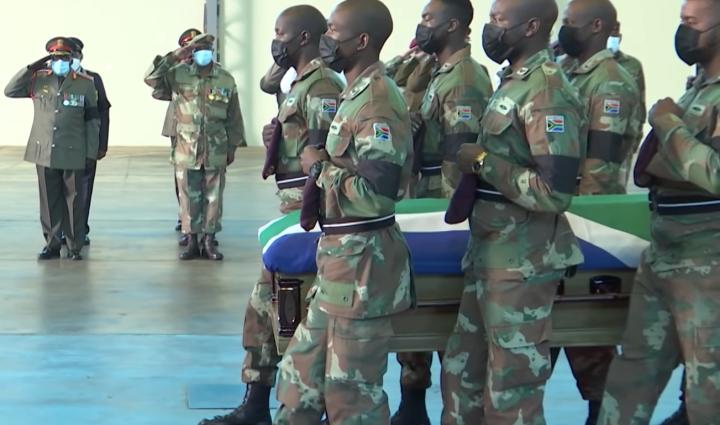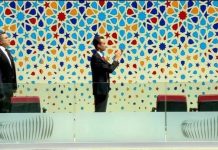
Africa-Press – Mauritius. Southern African leaders meeting in Malawi this week must reinforce their military mission fighting insurgents in northern Mozambique, a mission which is “ridiculously under-resourced for the task it has been given”.
South Africa lost its first soldier in the operation last month. Without a lot more infantry and equipment, casualties could start rising and the entire mission could be jeopardised.
That’s the urgent message from military experts as well as a small, but plucky contingent of special forces who are effectively fighting the Islamic State-affiliated extremist group and killing many of its members.
But they are almost on their own, without infantry back-up or adequate air support and other logistics and cannot sustain the intensity of the conflict without major reinforcements.
The special forces of South Africa, Tanzania, Botswana and Lesotho have been in northern Mozambique’s Cabo Delgado province since mid-July 2021 as part of the SADC Mission in Mozambique (Samim).
SADC — the Southern African Development Community — is holding an extraordinary summit in Lilongwe, Malawi, on Wednesday this week to decide on the future of the military intervention when its current mandate expires on 15 January.
SADC ministers have recommended to their leaders that Samim’s mandate should be extended by six months to mid-July. Officials told Daily Maverick that they expect the heads of government will endorse this extension.
But it’s not clear if they will also agree to beef up the mission — which is urgent. Military officials originally envisioned Samim as a force of almost 3,000 soldiers with a few hundred special forces soldiers in the vanguard, to be bolstered by three battalions of infantry.
They were also supposed to be supported by several attack and transport helicopters and other air and naval support. But the infantry have not been deployed and neither have the helicopter gunships.
A South African Navy strike craft was sent to Cabo Delgado last year, but then withdrew because of mechanical problems and has not been replaced, according to media reports.
Two South African Air Force Oryx utility helicopters are doing most of the airlifting, providing vital support to a few hundred special forces from South Africa, Tanzania, Botswana and Lesotho.
Angola, Democratic Republic of the Congo, Malawi and Zambia are also contributing to Samim, but mostly with logistics. The two Oryx helicopters are clearly overstretched and both have been hit by gunfire, sources say.
They are battling to supply reinforcements for forces that come under attack because of their many other assignments in a rising number of clashes with the enemy.
South Africa lost its first soldier in the operation when South African Special Forces (SASF) Corporal Tebogo Radebe was killed in an ambush east of the village of Chai in Cabo Delgado’s Macomia district on 20 December last year.
This followed an offensive launched by Samim and the Mozambique Armed Defence Forces (FADM) which captured two bases of the insurgents who call themselves Al Sunnah wa Jama’ah (ASWJ) and also Islamic State, Central Africa Province.
According to a Samim spokesperson, 14 insurgents were killed in the raid and 13 Mozambican civilians, believed to have been abducted by ASWJ, were freed.
Samim said a total of 23 insurgents had been killed in the weeks-long offence around Chai. It added, though, that apart from the South African who died, another two Samim members had been injured.
Military sources said the two Samim soldiers injured were SASF soldiers who had been shot in an engagement with ASWJ on 19 December. Early in September, another SASF soldier had been injured, they added.
Later, on 25 September, Samim said, a Tanzanian special forces soldier had been killed and another two Tanzanian special forces soldiers and one Lesotho special forces soldier injured in a joint Samim and FADM attack which destroyed an ASWJ base, south of Chitama settlement in Nangade District, Cabo Delgado province.
Samim said that 17 ASWJ terrorists had been killed in this operation and another was killed the next day in a firefight south of Messalo River. The total number of Samim casualties now seems to stand at 11.
Apart from the two killed and six injured in firefights with ASWJ, one Tanzanian soldier had died falling from a helicopter, a Lesotho soldier had died from cerebral malaria and a Botswana soldier had died when he was accidentally run over by a truck.
Mozambique, Samim — and the Rwanda Defence Force, which has a much larger force deployed in Cabo Delgado than SADC has — are killing many more insurgents than they themselves are losing. But the special forces are nonetheless more overstretched than they need to be or should be in a counter-insurgency war.
Though the Rwandans were originally in the forefront of the early fighting, they appear to have subsequently stuck to a restricted mandate, protecting the liquid natural gas processing facilities at Afungi near Palma in the far northeast of Cabo Delgado and also to keep open a 70km corridor from there to the port of Mocimboa da Praia in the south.
This has left Samim and FADM to police a large warzone which has recently expanded, as their operations have driven some insurgents into Niassa province, west of Cabo Delgado.
Mozambican soldiers have been widely criticised for running away when attacked, but much of their problem seems to be that they are badly equipped, especially when it comes to ammunition.
Two Mozambican soldiers were killed in the same contact which cost Radebe his life and three had been wounded alongside the two South Africans injured the day before.
It’s not quite clear why SADC has not so far deployed the full envisaged Samim force, though the main obstacle is probably cost. In July last year President Cyril Ramaphosa told Parliament he needed R984-million to deploy about 1,500 SA troops into Mozambique for three months.
In October, SADC extended the Samim mission until 15 January. But the SA government has not budgeted any more funds and seems to have stretched out the R984-million to cover six months of operations by deploying only special forces and not much equipment.
So far, all the SADC countries participating in Samim seem to have financed their own contributions. However, officials have told Daily Maverick that SADC is negotiating with foreign donors to try to get further funding.
The journal Vrye Weekblad reported last week that the parlous condition of the state arms company, Denel, was part of the reason only two Oryx helicopters and no Rooivalk attack helicopters had been sent to Mozambique.
Darren Olivier, a director at the African Defence Review, warned that, “The SADC mission in Mozambique is ridiculously under-resourced for the task it has been given, and if the mission is simply extended without a change to that then we should expect many more casualties along with potential mission failures.
“The South African Special Forces troops currently deployed in Mozambique, along with their counterparts from other countries like Botswana, Lesotho, and Tanzania, are extremely capable soldiers who have done sterling work over the past few months.
But they are not superhuman, and have been given an impossible task. “Right now the SADC force is too small, has responsibility for too large an area, and has too few supporting assets like aircraft.
They have only two Oryx transport helicopters to support 300-400 troops deployed across a huge area and, worse, have limited vehicle mobility as a result of the region’s harsh terrain.
This has meant that most engagements, actions, patrols, and similar have had to be done on foot and without support from either aircraft or heavy weapons, making the troops vulnerable.
“That there haven’t been more casualties is testament to the quality of the troops, but they’re being squeezed ever tighter and pushed to the point of exhaustion. Mistakes will inevitably creep in, and even the best troops have limits.
“Moreover, when it becomes necessary to rotate the current forces out, as must be coming soon, it’s unlikely that enough replacement teams will be available from the relevant countries’ special forces units. Will the deployment remain the same size, but with more conventional units? That will be a recipe for disaster.
“It’s therefore time to rethink the entire mission, and for SADC’s political and military leaders to both clarify the strategic objectives and commit to either properly resource the mission with the additional troops, transport helicopters, and heavy weapon support that it needs or withdraw from active combat operations entirely.
Wars can’t be fought on the cheap without severe consequences arising sooner or later. ” On Monday, Ramaphosa chaired a meeting in Lilongwe of the troika of SADC’s organ on politics, defence and security and of the other countries contributing troops to Samim, to draft recommendations for the full SADC summit on Wednesday.
“Since the deployment of Samim in Mozambique, significant progress has been made,” he said.
“The security situation in Cabo Delgado is improving, which has allowed for some internally displaced persons to return to their homes and resume their normal lives.
” Samim and FADM had opened safe passage for the supply of humanitarian aid to the people affected by the insurgency.
But Ramaphosa said there had also been challenges and “a magnitude of ground that still needs to be covered in the work of Samim. Therefore, we cannot let our guard down. He called for “a strengthened commitment to defeat and uproot terrorism from our region”.
For More News And Analysis About Mauritius Follow Africa-Press






